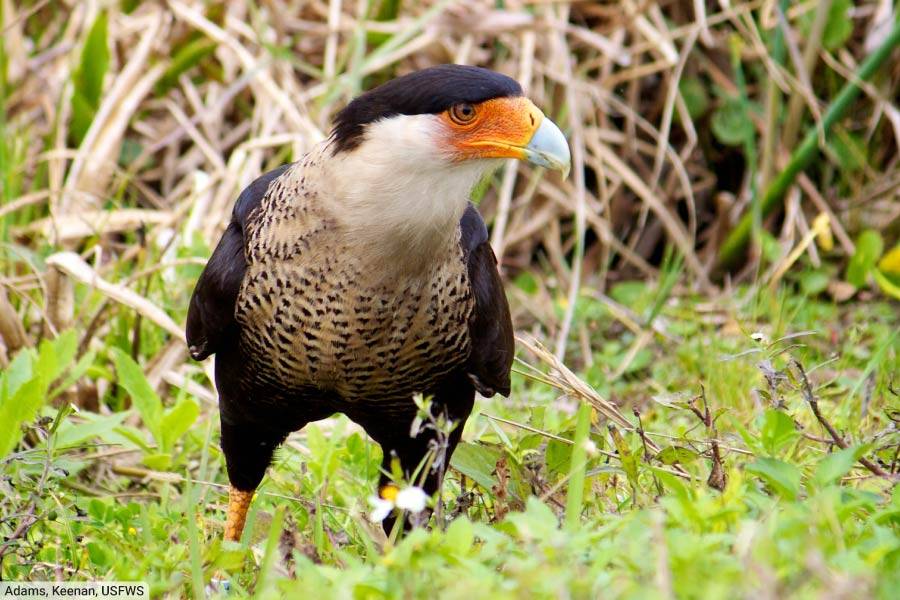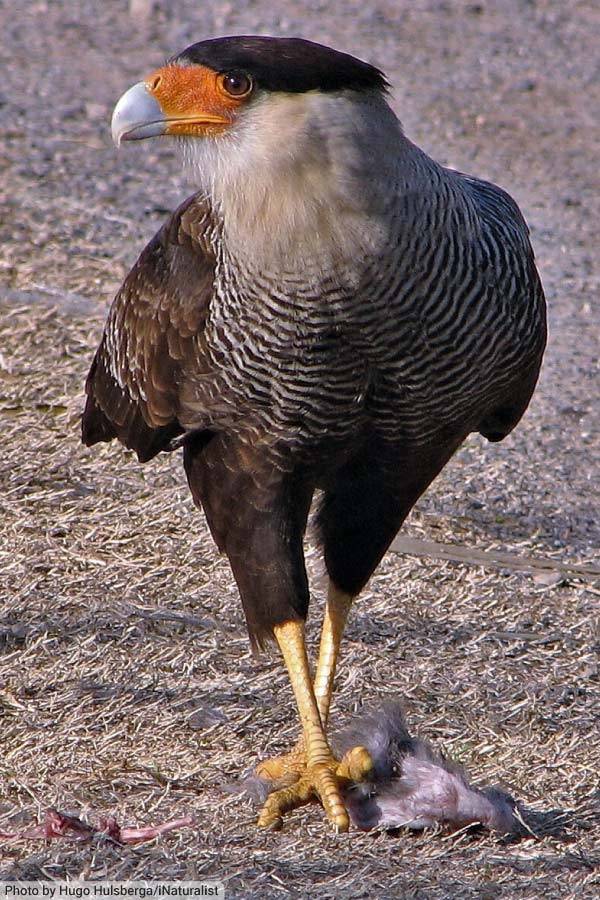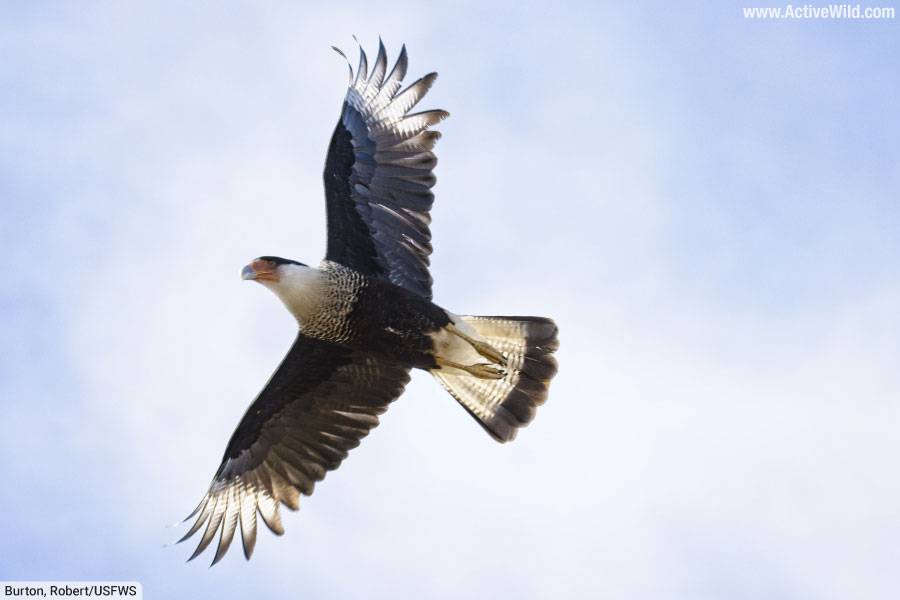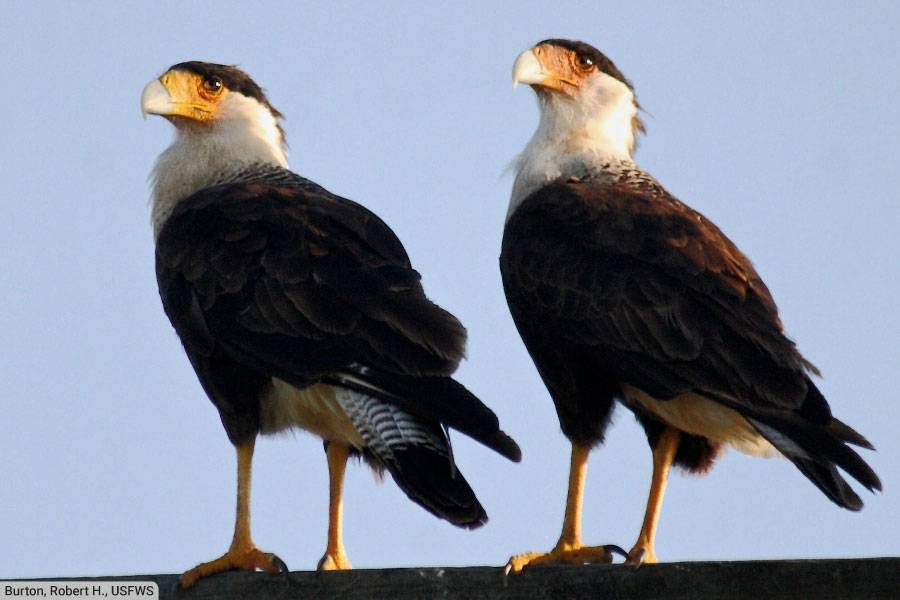
The crested caracara is one of the world’s most unusual birds of prey. A member of the falcon family, it is distinguished by its striking appearance and ground-based hunting habits.
Native to the open landscapes of the Americas, from the southernmost United States down to South America, this raptor stands out with its striking black and white body, fiery orange face and long legs.
The versatile crested caracara is both a formidable hunter and a scavenger, often seen striding confidently on the ground or soaring majestically in search of its next meal…
Crested Caracara Stats
- Scientific Name: Caracara plancus
- Other names: sometimes known as the “Mexican Eagle”
- Order: Falconiformes
- Family: Falconidae
- Length: 0.50-0.65 meters (1.6-2.1 feet)
- Weight: 0.8-1.3 kg (1.8-2.9 lb)
- Wingspan: 1.2-1.3 meters (3.9-4.3 feet)
- Where found: Southern United States down to South America, including parts of Central America
- IUCN conservation status: Least Concern (checked 05/11/23)
What is a Crested Caracara?

The crested caracara, Caracara plancus, is a distinctive raptor with a blend of black and white plumage complemented by a bold orange face and striking yellow legs. Despite being a member of the falcon family, Falconidae, it’s often mistaken for a vulture due to its scavenging behavior.
Native to wetlands, grasslands, scrublands and other open habitats of the Americas, the crested caracara’s range spans from the southern United States, through Central America, and reaches down into South America.
Unlike many of its falcon relatives that dominate the skies, the crested caracara is just as comfortable on the ground, and will often pursue its prey on foot.
The diet of the crested caracara is broad, ranging from carrion to small animals captured by the bird itself.
The crested caracara’s diverse and adaptable feeding habits allow it to thrive in various environments and conditions, from the arid landscapes of the American Southwest to the wetlands of Florida and the expansive grasslands of South America.
Crested Caracara Identification

With its large size, hooked beak, and carrion-eating behavior, the crested caracara, at first glance, might be mistaken for a vulture. Seen clearly, however, the species is unmistakable, with its contrasting black and white body plumage, yellow-orange face, and long, yellow legs.
The crested caracara’s body is primarily black / dark brown, with contrasting white to cream-colored neck and underparts. The neck and chest exhibit a black barring against a white background, providing the crested caracara with a “necklace” appearance.
One of the most striking features of the crested caracara is its bald, yellow-orange face. Atop the bird’s head is a cap of longer black feathers (the “crest” of the species’ name). The caracara’s eyes are amber.
The crested caracara’s strong beak, typical of birds of prey, is slightly hooked at the tip, ideal for tearing into its varied diet. The bird’s long, yellow legs and taloned feet are perfect for walking and running on the ground to seize prey.
In flight, the crested caracara has a broad wingspan and relatively short, squared-off tail. Its body and most of its wings are black; its neck, tail and the tips of its wings are white.

The crested caracara is the world’s second-heaviest member of the falcon family (after the gyrfalcon).
Juveniles tend to have a brownish overall plumage, in contrast to the sharp black and white plumage of the adults. Their underparts might have a mottled or streaked appearance, rather than the clear barring and contrast seen in mature birds. Their faces, beaks and legs are also paler / duller than those of adult birds.
Where are Crested Caracaras Found?
The crested caracara has a wide distribution across the Americas. Its range includes:
- United States: In the U.S., the crested caracara is primarily found in the southern parts, especially in Florida, Texas, and Arizona. Its presence in the U.S. is at the northernmost edge of its distribution.
- Mexico: The bird has a significant presence throughout Mexico, especially in the central and northern regions.
- Central America: The crested caracara can be found in several Central American countries, including Belize, Guatemala, Honduras, Nicaragua, Costa Rica, and Panama.
- South America: In South America, its range stretches from Colombia and Venezuela in the north down through Brazil, reaching as far south as northern Argentina and Uruguay. The bird is particularly common in open habitats of the llanos and cerrado regions.
Habitat
The crested caracara favors open or semi-open landscapes, such as savannas, grasslands, marshes, and pastures. It can also be found in scrubby woodlands and, sometimes, even in more urbanized areas or near roadsides where food might be available.
Crested Caracara Diet
The crested caracara is an opportunistic feeder, showcasing a versatile diet that encompasses a range of items, both hunted and scavenged. Here are some of the primary components of its diet:
- Carrion: One of the primary food sources for the crested caracara is carrion. The bird is often seen feeding on road-killed animals or other deceased wildlife, taking advantage of easy meals whenever available.
- Small animals: The caracara hunts and consumes a variety of small animals, including rodents like mice and rats, small birds, amphibians, and reptiles such as lizards and snakes.
- Insects: Insects, particularly large ones like grasshoppers, beetles, and crickets, form a part of the caracara’s diet, especially when other food sources are scarcer.
- Fish: On occasion, the crested caracara may capture and eat fish from shallow waters.
- Bird Eggs and Nestlings: The caracara has been known to raid bird nests to consume eggs or nestlings, showcasing its opportunistic nature.
- Fruits and Plants: Though primarily carnivorous, the caracara sometimes consumes plant matter, particularly fruits, complementing its varied diet.
Crested Caracara Family And Related Species
The crested caracara is the second-heaviest member of the 65 currently-recognized species within the falcon family, Falconidae. (The largest falcon is the gyrfalcon).
The crested caracara is the only extant (living) member of the genus Caracara. Previously, the northern crested caracara and southern crested caracara were treated as separate species, Caracara cheriway and Caracara plancus, respectively. They are now considered subspecies of a single species, Caracara plancus.
Crested Caracara Life Cycle & Lifespan

The female crested caracara typically lays a clutch of 2 eggs in a nest, which is usually built in a tall tree or cactus, but occasionally on the ground. The eggs are whitish with brown markings. The nest, which may be over 0.6 m / 2 ft. in diameter, is usually used by the same pair year after year.
Mated pairs stay together for multiple years and are highly territorial, showing aggression even to larger birds such as vultures that venture into their territory.
Both parents share incubation duties, though the female tends to take on the majority of this role. The incubation period lasts around 28 to 32 days; the fledgling period from 6 to 8 weeks.
Crested caracaras reach sexual maturity around the age of 3 to 4 years. As they transition to adulthood, their plumage shifts to the characteristic black and white, and they exhibit other physical changes like the brightening of facial skin and eye color.
Once mature, crested caracaras often form monogamous breeding pairs. These pairs engage in courtship displays that might include aerial maneuvers, vocalizations, and mutual preening. Together, they will raise their young, and the life cycle begins anew.
Is the Crested Caracara Endangered?
The crested caracara is not an endangered species; its current IUCN rating (last checked Sept 2023) is “Least Concern”.
Discover More With Active Wild
Visit our main animals page for links to animal information and a complete guide to the animal kingdom: Animals
You can see more South American animals on this page: South American Animals
You can find out more about birds on this page: Birds – The Ultimate Guide
Discover different types of birds on this page: Types of Birds
The post Crested Caracara Facts, Pictures, Complete Species Guide appeared first on Active Wild.